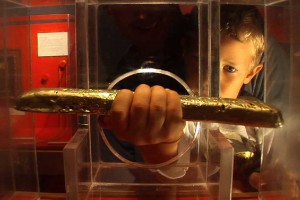Two men who stole a 17th century Spanish gold ingot from the Mel Fisher Maritime Museum in Key West in 2010 were finally found in January and arrested. (Why it took the feds more than seven years to find two monster douchebags filmed by security cameras during the crime remains unexplained.) Richard Johnson and Jarred Goldman were charged with conspiracy to commit an offense against the United States and theft of an object of cultural patrimony. The conspiracy charge carries a maximum sentence of five years, the theft ten.
 The men have now been convicted and sentenced to jail time. Johnson, who broke into the display case in broad daylight and walked out casually past security with the priceless object in his pocket was sentenced to serve 63 months (five years and three months). Goldman, who acted as a lookout, was sentenced to 40 months (three years and four months). Considering they could each have gotten 15 years, they both got off easy.
The men have now been convicted and sentenced to jail time. Johnson, who broke into the display case in broad daylight and walked out casually past security with the priceless object in his pocket was sentenced to serve 63 months (five years and three months). Goldman, who acted as a lookout, was sentenced to 40 months (three years and four months). Considering they could each have gotten 15 years, they both got off easy.
Unfortunately whatever time they end up doing will not be in a prison hulk, oubliette, dungeon or Roman silver mines even though retributive justice cries out for a prolonged period experiencing history’s most foul forms of punishment because of what they did to that ingot. They did not sell it to an unscrupulous collector. Like so many of these two-bit clowns, they wouldn’t have the first idea of how to unload so famous and specific an artifact. They didn’t have the 9th grade level of chemistry knowledge to melt it down and sell the gold for its market value. Instead they cut it up into small pieces and sold snippets in Las Vegas for pennies on the dollar. Obviously when I wrote that I hoped they wouldn’t just melt it for 70 grand worth of meth, I was way overestimating their abilities. Johnson doesn’t even have the decency to be addicted to meth. He blames a risibly expensive pot habit ($700 a week, really?) for driving him to it. That and childhood abuse at the hand of an uncle.
Those are just excuses thrown like spaghetti against the courtroom wall to see if any of them would stick and get him a lighter sentence. The museum offered a $10,000 reward for the return of the ingot. He didn’t have to destroy an irreplaceable historic artifact for loose change, no matter how refined his taste in weed.
Johnson cooperated with the feds and testified against Goldman at his trial, hence his far too generous sentence. He also provided information that allowed authorities to recover one of the snippets he cut off the ingot. It’s about 1/30th of the whole so it’s not much consolation.
Both men must also pay $570,195 in restitution to the museum for the bar, which the museum valued at over $560,000 at the time of the theft. Martinez said he didn’t expect either convict would be able to come up with much money.
Insurance paid the museum about $100,000 for the bar, which was recovered in 1980 by treasure hunter Mel Fisher and his team from a centuries-old shipwreck off the Florida Keys. […]
“That’s the point of view of insurance companies and jewelers,” museum CEO Melissa Kendrick testified Monday as Johnson’s attorney, Chad Piotrowski, argued the bar was worth the rate of gold and no more in an effort to secure a lesser sentence for his client. “As professionals, we don’t see it that way.”
Kendrick said, “The cultural community doesn’t value a Rembrandt for the cost of canvas and the paint.”